|
HISTORIC HIGHWAY BRIDGES OF OREGON
|

|
APPENDIX F
NOTABLE HIGHWAY BRIDGES CONSTRUCTED AFTER 1940
The historic bridges study was designed in accordance with the basic eligibility requirements for National Register listing. One of these requirements is that properties be at least fifty years old, unless of exceptional significance. The historic bridges study systematically inventoried Oregon's highway bridges built prior to 1941. Although this cutoff date includes some bridges a few years younger than fifty years, it was established to keep the study results current for several years and to allow for advanced planning. The study did, in addition, examine several notable bridges constructed after 1940 to test for exceptional historic significance.
Eight bridges were identified as notable post-1940 construction bridges. The study review team found none of these structures of exceptional historic significance and concluded that they were presently ineligible for the National Register.
The post-1940 bridges are identified below and are shown on the following pages. They are arranged chronologically by date of construction.

|
|
Little River (Cavitt Creek) Bridge Structure Number 19C18 Constructed - 1943 Timber Through Truss (Howe) Covered Bridge Cavitt Creek County Road 17 Glide vicinity, Douglas County Ownership - Douglas County |
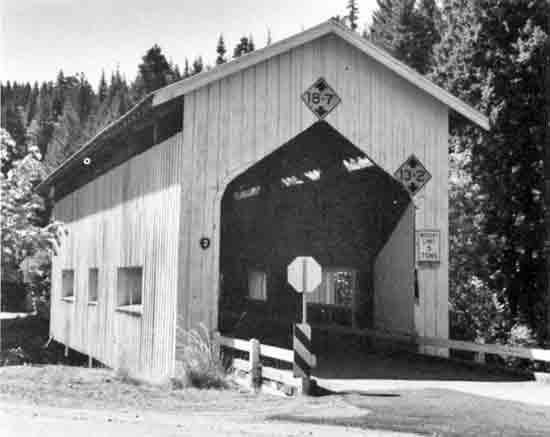 |
|
This covered bridge is distinctive for its Tudor-shaped portal arches and unhewn timbers (as upper and lower chord members). Built by veteran Douglas County covered bridge builder Floyd C. Frear, the structure is a 70-foot housed Howe truss. The structure spans Little River near its confluence with Cavitt Creek, hence the name of the bridge. This covered bridge was included in the thematic nomination of Oregon's covered bridges to the National Register in 1979, but was not listed at the request of Douglas County. | |
|
Santiam River Bridges Structure Numbers 2541 and 8123 Constructed - 1946 and 1958 Twin Steel Through Tied Arches Pacific Highway 1 (I-5), M.P. 240.66 Jefferson vicinity, Marion-Linn counties Ownership - State of Oregon |
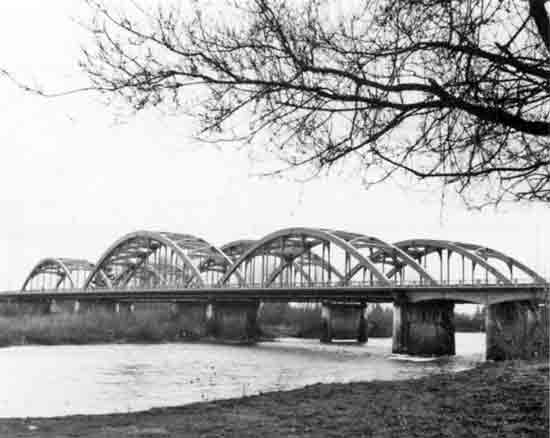 |
|
The easternmost of these two arch bridges was constructed in 1946 on the Pacific Highway, while its twin was built in 1958 when Interstate 5 was constructed. Both structures are three-span (180', 240' and 180') steel through tied arches flanked by six reinforced concrete deck girder approach spans. The 1946 structure serves northbound traffic, and the 1958 structure, southbound. Glenn S. Paxson, State Bridge Engineer, was the designer of the first bridge. | |
|
Crabtree Creek (Bohemian Hall) Bridge (Also, Richardson Gap Bridge) Structure Number 12890 Constructed - 1947 Timber Through Truss (Howe) Covered Bridge Richardson Gap County Road 25 Scio vicinity, Linn County Ownership - Linn County |
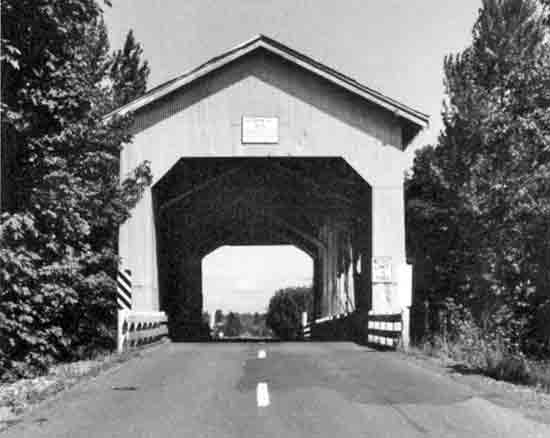 |
|
One of three covered bridges in Oregon enclosed entirely with metal instead of wood siding, this structure is a 120-foot housed Howe truss. The bridge was known as the Richardson Gap Bridge after the Richardson family, who settled in the area in the 1880s. The bridge is also known as the Bohemian Hall Bridge from the nearby fraternal lodge established by Czechoslovakian immigrants in the 1920s. The bridge contains the open truss plan typical of seven Linn County covered bridges. The bridge was built by the Lindstrom Brothers at a cost of $40,000 in 1947. This covered bridge was included in the thematic nomination of Oregon's covered bridges to the National Register in 1979, but was not listed at the request of Linn County. | |
|
Thomas Creek Bridge Structure Number 8459 Constructed - 1961 Steel Deck Truss (Warren with Verticals) Oregon Coast Highway 9, M.P. 374.78 Brookings vicinity, Curry County Ownership - State of Oregon |
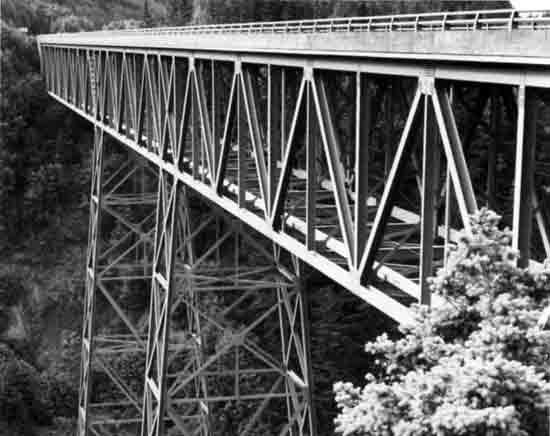 |
|
This structure is the highest bridge in Oregon at 345 feet and spans a deep ravine on the Oregon Coast. (The second highest bridge is the High Bridge across the Crooked River in Jefferson County at 295 feet.) The bridge consists of three steel deck trusses (maximum span, 371 feet), supported on steel frame towers on concrete piers. The trusses are Warrens with verticals. The overall length of the bridge is 956 feet. The bridge was designed by Ivan D. Merchant, State Bridge Engineer, and constructed by the State Highway Department. | |
|
Crooked River (Lake Billy Chinook) Bridge Structure Number 16C06 Constructed - 1962 Steel Suspension Jordan County Road 579 Madras vicinity, Jefferson County Ownership - Jefferson County |
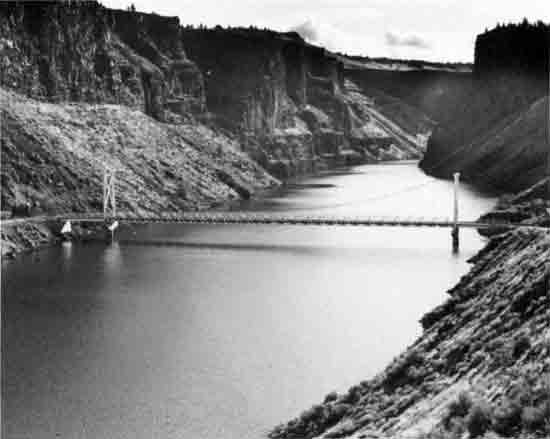 |
|
Located at the south end of Cove Palisades State Park in Jefferson County, this structure is a 588-foot steel suspension span. This bridge and the St. John's Bridge across the Willamette River in Portland are the only large suspension bridges in Oregon. The bridge was built in conjunction with the Round Butte Dam and Lake Billy Chinook reservoir project. (Billy Chinook was an Indian scout and guide with the John C. Fremont and Kit Carson expedition to Central Oregon in 1843-44.) | |
|
Columbia River (Astoria) Bridge Structure Number 7949 Constructed - 1966 Steel Through Truss (Cantilever) Oregon Coast Highway 9, M.P. 0.00 Astoria, Clatsop County (Oregon) and Megler vicinity, Pacific County (Washington) Ownership - State of Oregon |
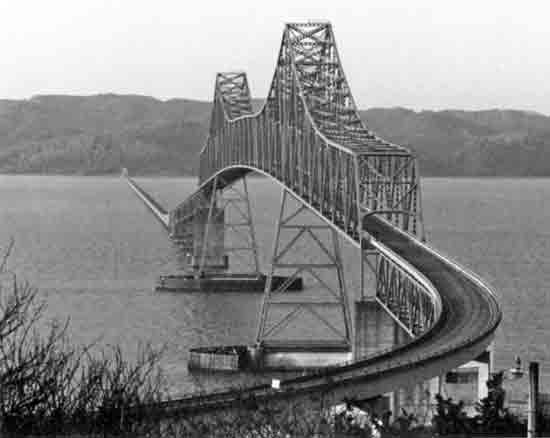 |
|
At just over four miles in length (21,474 feet), the Columbia River Bridge at Astoria is the longest bridge in Oregon. The main span of the structure is a 2,468-foot steel cantilever through truss made up of two 618-foot outer truss sections and a 1,232-foot central truss span. This cantilever truss is flanked by five steel deck trusses, one-hundred-forty 80-foot concrete deck girder spans, and, at the Washington end of the bridge, seven 350-foot steel through truss spans. The bridge was designed jointly by the state highway departments of Oregon and Washington. Ivan D. Merchant was the state bridge engineer for Oregon. Construction began on the structure in 1962 and was completed in July 1966. | |
|
Thomas Creek (Shimanek) Bridge Structure Number 12965 Constructed - 1966 Timber Through Truss (Howe) Covered Bridge Richardson Gap County Road 673 Scio vicinity, Linn County Ownership - Linn County |
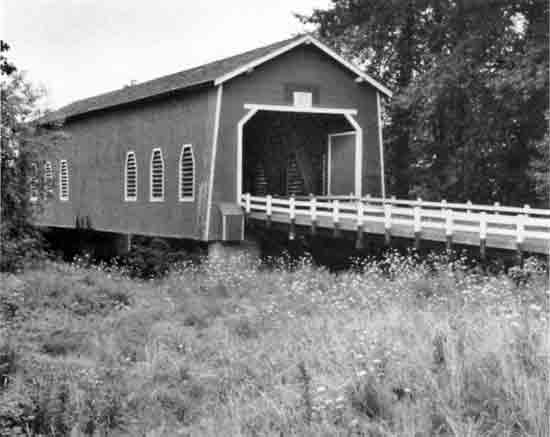 |
|
One of the youngest of Oregon's covered bridges, this is the fifth covered bridge at this location. The earliest bridge at this site, an uncovered structure, was built in 1861. Later, covered bridges were constructed in 1891, 1904, 1921, and 1927. Named for the pioneer Shimanek family, this structure is a 130-foot housed Howe truss. The bridge was designed by W.A. Palmateer and built by the Hamilton Construction Company of Springfield. This covered bridge was not listed on the National Register at the request of Linn County, but was included in the thematic nomination of Oregon's covered bridges in 1979. | |
|
Willamette River (Fremont) Bridge Structure Number 2529 Constructed - 1973 Steel Half-Through Tied Arch Stadium Freeway 61 (1-405), M.P. 3.32 Portland, Multnomah County Ownership - State of Oregon |
 |
|
When constructed, the Fremont Bridge was the largest of its type, a stiffened steel tied arch with an orthotropic upper deck. The 902-foot tied arch midspan was constructed off-site, floated into place, and its 6,000-ton weight hydraulically lifted 170 feet into position, establishing a place in the Guinness Book of World Records as the biggest lift ever made. The total length of the superstructure is 2,159 feet or 7,312 feet including approaches. The Fremont has no inwater pier supports, as the design keeps deadweight to a minimum. The bridge was designed for ten lanes of traffic, five on each level of the roadway. The Fremont Bridge was designed by Parsons, Brinckerhoff, Quade, and Douglas of New York, under contract by the Oregon State Highway Division. Ivan D. Merchant and Walter J. Hart were the state bridge engineers during the bridge planning and construction period. | |
| <<< Previous | <<< Contents>>> | Next >>> |
appf.htm
Last Updated: 06-Aug-2008